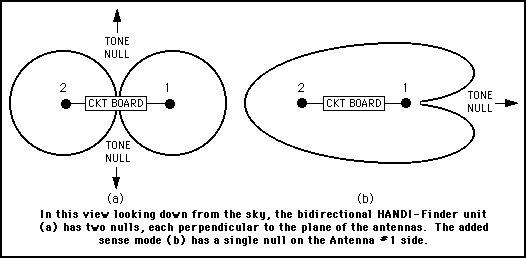
The following was submitted to the Technical Correspondence column in QST Magazine for October 1993 in response to the HANDI-Finder construction project in a previous QST issue. The original HANDI-Finder was created by Bob Leskovec K8DTS. It is documented at the HANDI-Finder Web site. A kit of parts is sold by Northern Ohio Amateur Radio Development. "Clones" of the bow-tie bidirectional HANDI-Finder are being or have been offered for sale by some other companies and individuals. The KØOV unidirectional pattern modification and antenna improvements described below are applicable to all of these bow-tie sets.
Hats off to QST for its recent promotion of foxhunting and radio direction finding (RDF) activities. Simple RDF gear in the hands of a large number of hams will provide important preparedness for emergency searches and malicious interference location.
The HANDI-Finder® by K8DTS[1] holds promise for this purpose, but its bidirectional peaks and nulls limit it to short range "sniffing" in situations where time-to-locate is of little concern. Its 180-degree ambiguity makes it unsuitable for long-range or high-speed work.
If you were shopping for a compass to use on a hike, what would you think of one with an indicator that points either north or south, with no way of determining which? You probably wouldn't buy it, even if it was priced much lower than other compasses in the store. It's the same way with foxhunt equipment.
A bidirectional RDF set such as the basic HANDI-Finder presents a 50-50 chance of leading you away from the fox instead of toward it. So it's worthwhile only for occasions when boundaries are small, such as on-foot foxhunts in a small park. Fortunately, it's a simple matter to incorporate a second mode into your HANDI-Finder to resolve the ambiguity.

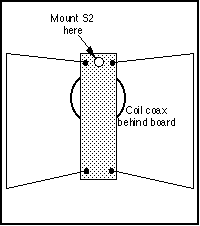 By adding time delay to the signal from one of the two HANDI-Finder antennas,
the peak/null tone pattern of the unit is modified. If you add just the right
amount of delay, the pattern changes from bidirectional (figure-8) with nulls
perpendicular to the antenna plane to cardioid (heart-shaped) with a single
null off one end.
By adding time delay to the signal from one of the two HANDI-Finder antennas,
the peak/null tone pattern of the unit is modified. If you add just the right
amount of delay, the pattern changes from bidirectional (figure-8) with nulls
perpendicular to the antenna plane to cardioid (heart-shaped) with a single
null off one end.
This two-pattern technique forms the basis of the Handy Tracker, a RDF unit that I designed in 1989.[2] The cardioid pattern concept came from an unpublished 1980 project by Russ Andrews K6BMG. The Handy Tracker sense mode scheme can be applied to the K8DTS HANDI-Finder with the simple addition of a switch and a length of coaxial cable to provide delay.
As K8DTS points out, the bidirectional HANDI-Finder indication is independent of frequency. This is not true of the added sense mode. A delay line of a given length produces a precise cardioid pattern at only one frequency. A useful pattern is obtained over a frequency range of several per cent, however, so one delay line will provide ambiguity resolution over one full VHF amateur band.
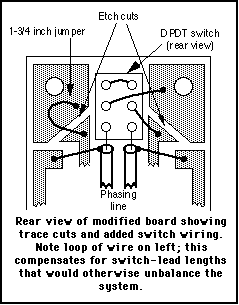 The modification adds a DPDT micro-mini toggle switch without center-off (Radio
Shack 275-626) and a precisely trimmed coax delay line. Mount the switch in
the etch-free area of the circuit board between the two antennas.
The modification adds a DPDT micro-mini toggle switch without center-off (Radio
Shack 275-626) and a precisely trimmed coax delay line. Mount the switch in
the etch-free area of the circuit board between the two antennas.
On the rear side, cut the traces where C6 and C7 connect to the antenna terminals per the drawing. On the Antenna #2 side, wire the antenna connection through the switch per the schematic. On the Antenna #1 side, install an unshielded wire jumper 1-3/4 inches long, to compensate for the added switch wiring on the Antenna #2 side. This jumper is important, since one inch of difference in feed length to one antenna will cause 6.5 degrees bearing error in the figure-8 mode.
Cut the delay line according to the following formula:
l = (11808-df)v/f
where l = length of coax in inches, v = velocity factor of coax as a fraction, f = frequency in MHz, and d = spacing between the vertical antennas in inches. For example, assume we are adding the sense mode to a HANDI-Finder with "bow tie" open loop antennas for two meters. The vertical sections of the two loops are 15 inches apart. We are using RG-174 coax, which has velocity factor of 65.9 per cent. Computed for the center of the band (146 MHz), delay line length is
(11808-(15)(146))(0.659)/146 = 43.4 inches.
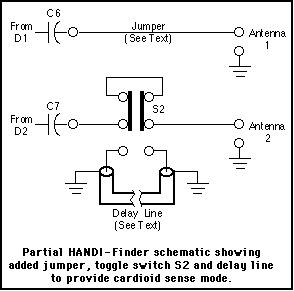 Coil up the coax and lace it to the board. Miniature coax such as RG-174 is
best for the delay line because it makes a compact coil. Whatever coax you
use, make sure to determine its characteristic velocity factor. It is
different for foam and non-foam type cables.
Coil up the coax and lace it to the board. Miniature coax such as RG-174 is
best for the delay line because it makes a compact coil. Whatever coax you
use, make sure to determine its characteristic velocity factor. It is
different for foam and non-foam type cables.
Because of environmental multipath and stray coupling, a perfect cardioid tone pattern may not be achieved. The end null may not be complete or there may be a double null on one end. This doesn't matter, because the purpose of the sense mode is merely to determine which of the two figure-8 nulls to follow. There is plenty of peak/null amplitude difference for that.
Getting RDF bearings with the modified HANDI-Finder is a simple two-step process. In a clear location, with S2 set for normal (bidirectional) mode, listen for the tone nulls in the receiver to obtain a line of bearing as described by K8DTS. Next, switch S2 to the cardioid pattern mode and turn the unit 90 degrees so that one end points along your line of bearing. Note the tone level. Rotate the unit 180 degrees and note the tone level again. It should be distinctly different. The lower amplitude tone will occur when Antenna #1 is closest to the signal source. To help you remember, mark the peak/null directions on the board.
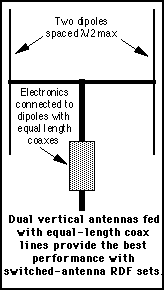 In the K8DTS QST article photo, the receiver feedline passes over the open end
of one antenna loop. This unbalances the antenna pair and can cause major
bearing errors on two meters and above. The coax should be routed away from
the loop.
In the K8DTS QST article photo, the receiver feedline passes over the open end
of one antenna loop. This unbalances the antenna pair and can cause major
bearing errors on two meters and above. The coax should be routed away from
the loop.
The horizontal sections of the bow tie antennas severely degrade RDF performance. Properly spaced coax-fed vertical dipoles are far better for serious use with this type of RDF set. Such an antenna set is easy to make with inexpensive whip antennas and PVC plumbing parts.
The two antennas should be spaced as widely as possible for maximum audible df tone, but spacing must not exceed one half free-space wavelength at the receiving frequency. Approximately 24 inch spacing is practical for both two meters and 125 cm. Coax cables from the HANDI-Finder board to each of the two vertical dipoles must be exactly equal in length.
Wide antenna spacing gives better performance, but it may increase the received tone deviation to the point that the receiver "squelches out." If this occurs, reduce the tone oscillator frequency to 400 Hz or lower by increasing the value of R1 and/or C1.
Footnotes:
[1] Leskovec, "Build the HANDI-Finder!" QST, May 1993, pp 35-38.
[2] Moell, "Homing In," 73 Amateur Radio, September 1989, pp 58-59 and November 1989, pp 52-53.
The spelling and form of HANDI-Finder constitutes a trademark registered to K8DTS.
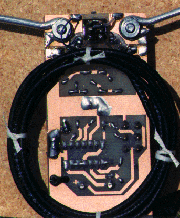
The added coax delay line is tied to the rear of the circuit board.
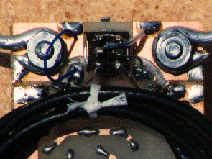
Close-up of top area of board, showing added DPST switch and wire jumper to provide equal signal paths in bidirectional mode.

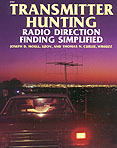 Back to "bow-tie" on the Frequently Asked Questions page
Back to "bow-tie" on the Frequently Asked Questions page
Back to the Homing In home page
This page updated 10 September 2025